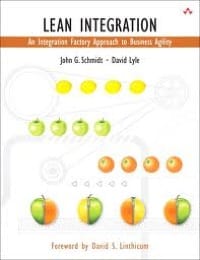New Book Review: "Lean Integration"
New book review for Lean Integration: An Integration Factory Approach to Business Agility, by John G. Schmidt and David Lyle, Addison-Wesley, 2010:


A text published several years ago by the same authors, "Integration Competency Center: An Implementation Methodology", initially captured my interest in this recently released book. Although the authors note in their introduction that this text builds on the earlier work, they also indicate that it is not necessary to read these sequentially. The concept of "lean integation" builds on prior works by other authors such as "Lean Software Development: An Agile Toolkit" by Mary and Tom Poppendieck (see my review), and because of my experience using Agile and Six Sigma, I have continued interest in how I might also apply Lean principles as a consultant. And this interest is especially in light of my involvement in various database and integation related efforts. In the context of this text, the authors broadly define "integration" as "the practice of making independent applications work together as a cohesive system on an ongoing basis", and indicate that solutions typically fall into either process integration or data integration.
This book is divided into three parts. The first provides an overview and justification for Lean as well as an overview of Lean practices and what the authors deem the "Integration Factory". The second part walks through the seven lean integration principles associated with the Integration Factory: focus on the customer and eliminate waste, continuously improve, empower the team, optimize the whole, plan for change, automate processes, and build quality in. The third part discusses best practices grouped by seven competency areas: financial management, integration methodology, metadata management, information architecture, business process management, modeling management, and integration systems. Aside from the typical glossary and terminology that the appendixes provide, the authors also include the "Integration Laws" from the predecessor to this book: "The whole is greater than the sum of its parts", "There is no end state", "There are no universal standards", "Information adapts to meet local needs", and "All details are relevant".
The first two parts of this book continued to capture my interest, and although the third part on implementation practices contains some relevant material, the lack of cohesiveness in these last few chapters was disappointing, and because the term "implementation" used here implies a bit more concreteness than was offered by the authors, my expectations were unfortunately not met. Exceptions include Chapter 11 on financial management, which addresses the ability to secure funding for integration projects, rightly calling this the weakest skills among IT professionals, and Chapter 16 on modeling management, in which the authors address important risks to IT professionals, such as the risk that use of Service-Oriented Architecture (SOA) can lead to new hairballs. As with another recently read book that I recommend, "Enterprise Master Data Management: An SOA Approach to Managing Core Information" published by IBM Press (see my review), one refreshing aspect of this text is that even though the authors are from Informatica, the content remains very much vendor neutral. Well recommended.